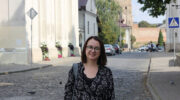First Look
Civilians reflect on Ukraine’s 2014 uprising in the midst of war
Ten years ago, Ukrainians protested President Viktor Yanukovychin’s decision to move the country away from the EU and toward Russia. The months-long standoff led to the ouster of Mr. Yanukovychin, and nine years later, an ongoing war with Russia.
| View caption Hide caption
|
It happens every November, when the cold descends on Kyiv. The change in weather always makes Dmytro Riznychenko think back, and he is overwhelmed by his emotions.
“This is where it truly began,” Mr. Riznychenko said, walking through central Kyiv’s Independence Square recently, reflecting on the uprising that unleashed a decade of momentous change for Ukraine, eventually leading to the current war with Russia.
“Ten years of war and struggle,” the psychologist continued, wearily and reluctantly. “And it seems like the blood has only just begun to flow, truly. I regret nothing. But, God, it’s just so tiresome.”
On Nov. 21, 2013, the Moscow-friendly president of Ukraine, Viktor Yanukovych, announced he was shelving an agreement to bring the country closer to the European Union and instead would deepen ties with President Vladimir Putin’s Russia.
Outraged crowds soon filled Independence Square for peaceful anti-government protests. Later, after riot police used truncheons and tear gas to disperse the people, demonstrators set up tent camps with barricades, self-defense units, and banners with revolutionary slogans. In response to the police violence, hundreds of thousands joined the demonstrations in early December.
The standoff reached a climax in February 2014, when police unleashed a brutal crackdown on the protests and dozens of people were slain between Feb. 18-21, many by police snipers. A European-mediated peace deal between the government and protest leaders envisioned the formation of a transition government and holding an early election, but demonstrators later seized government buildings, and Mr. Yanukovych fled to Russia.
The Ukrainian Institute of National Remembrance said 107 people were killed in the uprising.
Kateryna Gladka was a 23-year-old student when she joined the pro-Western crowds at the time, viewing it as the “revolution of her generation.”
“For me, the top priority was the value of freedom, basic freedom, and dignity.”
“We had to prevent a totalitarian regime and the return of Soviet things,” Ms. Gladka said in a telephone interview.
She recalls the police violence and blood staining the street near Independence Square, and “I very clearly understood that we had entered another stage.”
After Mr. Yanukovych’s ouster, Russia responded in March 2014 by illegally annexing Ukraine’s Crimean Peninsula. Then, separatist forces backed by Moscow began an uprising in the eastern Ukraine region known as the Donbas, which grew into a long-running conflict, leaving thousands dead.
Finally, in February 2022, Mr. Putin launched his war that continues to this day, with tens of thousands of deaths on both sides amid Europe’s biggest conflict since World War II.
“Yanukovych was that puppet, a figure for Moscow, which hoped to use him as a person to keep Ukraine on the Russian leash,” said Kateryna Zarembo, an analyst at the Kyiv-based think tank, The New Europe Center. “When he fled, it became clear to the Kremlin that they were losing Ukraine.”
Asked on Nov. 21 about the 10th anniversary of the start of the uprising in Kyiv, Kremlin spokesman Dmitry Peskov reiterated Russia’s view that it was “a coup, a forceful coup financed from abroad.”
Ukrainians in 2013 had wanted the country to enter into a deal with the EU, but Mr. Putin pressured Mr. Yanukovych to pull out at the last minute. Ukrainian leaders who followed were more eager than ever to bring Kyiv into the Western fold.
“So what we saw in 2022 – that Ukraine had to be either part of Russia or destroyed – those intentions were seen earlier,” Ms. Zarembo said. “When that didn’t happen, Russia intervened militarily.”
Despite the calamities, Ukraine has become more united than in its 32 years of independence and has drawn closer to the EU, the United States, and the West in general – an outcome Putin had tried to prevent. Today, under President Volodymyr Zelenskyy, the country has won widespread support and admiration amid the Russian invasion.
“All of this came at a very high cost,” Mr. Riznychenko said.
Standing on the Alley of Heavenly Hundred, so named to honor those killed in the uprising, he recalled the sniper fire from a special police unit known as Berkut, which was disbanded in 2014.
“There was a feeling that death had opened its arms,” Mr. Riznychenko said.
“It was cold, I remember how the dead were lying. I remember them under blankets near the Main Post Office. That I remember,” he added.
Now, their portraits are on permanent display on the street honoring those slain in what Ukraine calls its Revolution of Dignity, and Mr. Riznychenko said he later memorized the names. In 2014, he volunteered to fight in eastern Ukraine against the Moscow-backed separatists and was injured in Ilovaisk.
Investigations of the shootings are continuing, and the Prosecutor General’s Office recently indicted five members of the Berkut police unit, all now living in Russia. Another 35 people are being investigated.
Independence Square today also features a multitude of small blue-and-yellow flags, with each symbolizing a fallen soldier in the war. Their numbers grow daily.
Every year, Ms. Gladka gathers with friends at a nearby restaurant, aptly named The Last Barricade, to commemorate the uprising. But after 21 months of war with Russia, the date brings conflicting emotions.
“To be honest, I am personally very tired of the fact that every generation has to die for Ukraine,” she said, noting that 10 years of her youth have been stained by violence, and she now wants a “normal and ordinary life.”
“This endless struggle is like some closed circle that just lasts for centuries,” she said.




